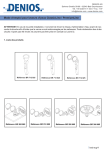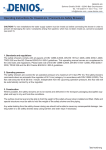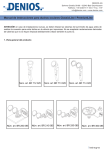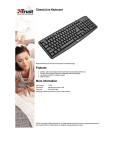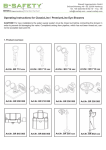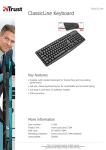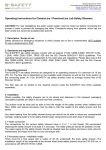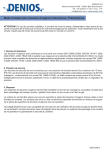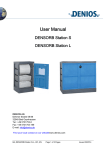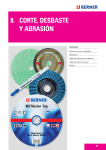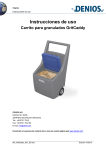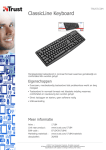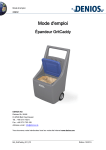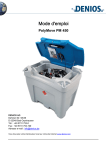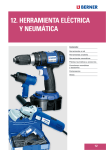Download Operating Instructions for ClassicLine / PremiumLine
Transcript
DENIOS AG Dehmer Straße 58-66 • 32549 Bad Oeynhausen Tel. +49 (0)5731 7 53-0 • Fax. -197 [email protected] • www.denios.com Operating Instructions for ClassicLine / PremiumLine Eye Showers CAUTION! For new installations the water supply system must be rinsed out before connecting the shower in order to prevent dirt damaging the valve. Complaints arising from pipeline, which has not been rinsed out, cannot be accepted (see point 5). 1. Product overview: Art.Nr. BR 712 025 Art.Nr. BR 713 025 Art.Nr. BR 714 025 bed-aug-eng DENIOS AG Dehmer Straße 58-66 • 32549 Bad Oeynhausen Tel. +49 (0)5731 7 53-0 • Fax. -197 [email protected] • www.denios.com 2. Standards and regulations The eye showers correspond in all respects to DIN EN 15154-2:2006, the ANSI Z358.1-2009, the Technical Rules for Hazardous Substances (TRGS) 526 and the regulation of the BG Chemie (professional association for chemistry) BGI/GUV-I 850-0. These operating instructions are intended as a supplement to the statutory regulations and provisions. Please comply with DIN EN 15154-2:2006, the ANSI Z358.1-2009, the TRGS 526 and the BG Chemie regulation BGI/GUV-I 850-0. 3. Operating pressure The eye showers are designed for an operating pressure of a maximum of 10 bar (PN10). 3.1. Eye showers with one high-performance spray head: To guarantee correct operation, the flow pressure must be at least 1.5 bar. The flow rate is 6 to 8 litres per minute. This flow rate specified by the standard is set automatically by a flow regulator integrated in the eye shower irrespective of the existing operating pressure. 3.2. Eye showers with two high-performance spray heads: To guarantee correct operation, the flow pressure must be at least 2 bar. The flow rate is 13 to 15 litres per minute. This flow rate specified by the standard is set automatically by a flow regulator integrated in the eye shower irrespective of the existing operating pressure. 4. Installation 4.1 Items supplied: - Eye shower consisting of hand-held piece / valve body and spray head / spray heads - Stainless steel coated hose with tapered end and connection nut (only hand-held eye showers) - Table bracket, wall bracket, 45° wall bracket or wall flange - Eye shower emergency sign 4.2 Installation: To avoid damage to furniture and the floor the shower should be installed near a drain so that water from the shower can be channelled away. 4.2.1 Table mounted eye showers, product code BR 200 xxx: Install using the table mounting accessories M28x80mm. A hole of 30 mm diameter should be made in the table top at a suitable point. The table mounting accessories will be mounted with the plastic rosette and the counter nut below the table surface. 4.2.2 Wall mounted eye showers, product codes BR 250 xxx, BR 300 xxx: BR 250 xxx / BR 300 xxx: Install using the wall flange. The wall flange should be installed with a suitable fastening system on a flat surface (wall). DENIOS AG Dehmer Straße 58-66 • 32549 Bad Oeynhausen Tel. +49 (0)5731 7 53-0 • Fax. -197 [email protected] • www.denios.com 4.2.3 Wall-/table mounted hand-held eye showers, product codes BR xxx 025: Install using the combined wall and table bracket. When using the combined bracket as a wall bracket, the brass pipe must be unscrewed by hand - ensure that work gloves are worn for this. The wall bracket should be mounted on an even surface (wall) using a suitable fixing system. When using as a table bracket, refer to the points under 4.2.1. 4.3 Position of strainer and gasket (Hand-held eye showers) The strainer must be mounted between the eye shower and the hose; the gasket must be mounted between the water inlet and the hose. 5. Water supply The eye shower should be connected to drinking water. The drinking water system should be constructed in accordance with DIN 1988 and DIN EN 1717. CAUTION! For new installations the water supply system must be rinsed out before connecting the shower in order to prevent dirt damaging the valve. 5.1 Water supply for hand-held eye showers The hand-held eye shower is connected to the water supply using the ½ inch connection nut on the hose. The hand-held eye showers are fitted with a backflow preventer according to DIN 1988 protection class 2 (3 for short periods). In addition, a second backflow preventer can be obtained from specialised traders to achieve a higher protection class. 5.2 Water supply for eye showers The eye showers are connected with the wall flange, the table mounting accessories or the water supply, which is provided for it. DENIOS AG Dehmer Straße 58-66 • 32549 Bad Oeynhausen Tel. +49 (0)5731 7 53-0 • Fax. -197 [email protected] • www.denios.com 6. Safety labelling The enclosed safety label (self-adhesive information sign, product code: BR205010) should be affixed beside the eye shower. 7. Location The location must be selected in accordance with regulation BGI/GUV-I 850-0 of the BG Chemie. Access must be kept free at all times. Special attention should be given to selecting a place which can be reached quickly from hazard areas. The injured person must be able to reach the shower within a maximum of 10 seconds. This necessitates installation at a distance of no more than 10 metres from the work place. 8. Operating 8.1 Operating of hand-held eye showers Commissioning the hand-held eye shower is carried out by pressing the button on the handle. This locks the button in the open position. To switch off the shower, press the button again while pulling down the locking device. When suitably mounted, the hand-held eye shower can be operated both in and out of the bracket (table feedthrough, wall bracket). Operating the shower in the holder makes it possible to hold open the lids of the contaminated eyes with both hands at the same time. The shower can also be removed from the bracket. This allows other body parts or an injured person on the floor to be treated. 8.2 Operating of eye showers Commissioning the eye shower is carried out by pressing the big PUSH lever. This locks the PUSH lever in the open position. To switch off the shower, pull back the PUSH lever. 8.3 Eyewash in First-Aid-Case The eye shower should not come into direct contact with the contaminated eye or its surroundings. The black rubber cup on the shower is only intended to prevent impact injuries. Optimum rinsing is achieved at a distance of approx. 150 mm. At this distance, the diameter of the spray cone is approx. 80 mm. To use the shower, it is advisable to hold the eye open with both hands. 8.4 Self-draining of spray heads The spray head / spray heads must be emptied each time after use by holding the shower with the head pointing downwards. This avoids standing water remaining in the spray head and minimises the likelihood of microbial contamination. 9. Maintenance eye showers must undergo a function test at least once a month. This is set down in regulation BGI/GUV-I 850-0 of the BG Chemie. To do this, activate the shower for approx. 5 seconds. This ensures not only that correct function is tested but that any standing water in the shower is replaced by fresh water (protection against microbial contamination). As part of this function test, the shower should be checked visually for signs of wear and tear and any possible leaks and dirt such as e.g. dust or scale deposits. Inspect the hose for any twisted, bent or otherwise damaged places. Faulty parts must be replaced immediately. 10. Procedure for leaking hand-held eye showers After connecting to the cold water system, the hand-held eye shower may have started to leak. This is generally due to dirt from the water supply which collects in front of the valve. If this has happened, disconnect the handheld eye shower from the supply. Operate the shower a few times without pressure and rinse the pipe thoroughly before reconnecting. If the fault cannot be remedied by this means the enclosed mesh filter must be fitted in front of the stainless steel hose. Operating Instructions ClassicLine / PremiumLine Eye Showers B-SAFETY 01-2012 bed-aug-eng




